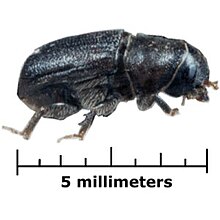| Bark beetles Temporal range:
| |
|---|---|

| |
| Mountain pine beetle, Dendroctonus ponderosae | |
| Scientific classification | |
| Domain: | Eukaryota |
| Kingdom: | Animalia |
| Phylum: | Arthropoda |
| Class: | Insecta |
| Order: | Coleoptera |
| Family: | Curculionidae |
| Subfamily: | Scolytinae Latreille, 1804 |
| Tribes | |
|
Cortylini | |
A bark beetle is the common name for the subfamily of beetles Scolytinae.[1] Previously, this was considered a distinct family (Scolytidae), but is now understood to be a specialized clade of the "true weevil" family (Curculionidae). Although the term "bark beetle" refers to the fact that many species feed in the inner bark (phloem) layer of trees, the subfamily also has many species with other lifestyles, including some that bore into wood, feed in fruit and seeds, or tunnel into herbaceous plants.[1] Well-known species are members of the type genus Scolytus, namely the European elm bark beetle S. multistriatus and the large elm bark beetle S. scolytus, which like the American elm bark beetle Hylurgopinus rufipes, transmit Dutch elm disease fungi (Ophiostoma). The mountain pine beetle Dendroctonus ponderosae, southern pine beetle Dendroctonus frontalis, and their near relatives are major pests of conifer forests in North America. A similarly aggressive species in Europe is the spruce ips Ips typographus. A tiny bark beetle, the coffee berry borer, Hypothenemus hampei is a major pest on coffee plantations around the world.
- ^ a b Kirkendall, Lawrence; Biedermann, Peter H.W.; Jordal, Bjarte (2015). "Chapter 3: Bark Beetles: Biology and Ecology of Native and Invasive Species". Bark Beetles: Biology and Ecology of Native and Invasive Species. Academic Press.